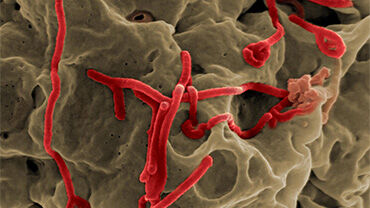Postcard from the field: Responding to the Ebola outbreak in Equateur Province, Democratic Republic of the Congo
In August 2020, Global Outbreak and Alert and Response Network (GOARN) sent a request for assistance for epidemiologists to be deployed to the Democratic Republic of the Congo (DRC) to support the Ebola virus disease (EVD) outbreak response in the Equateur Province. One month prior to this, the largest outbreak ever in eastern DRC had been declared over. Undetected cases? No, this request was due to a new unrelated outbreak in Equateur Province detected in June 2020, but with the ongoing COVID-19 pandemic, it had not been prominent in media reports.

When we arrived in October 2020, the outbreak was under control and no new cases had been detected for over a week. So, what do epidemiologists do when an outbreak is coming to an end? Well, contrary to what you might think, there is a lot of work to be done.
After the last confirmed case of EVD has tested negative, a countdown starts − 42 days, or twice the length of the incubation period without new cases – must pass before the outbreak can be declared over. During the countdown period, surveillance is crucial in order to detect any hidden chains of transmission. Therefore alerts were still being collected, verified and analysed on a daily basis. At the same time, investigations continued to identify the missing links in previously-reported cases and known chains of transmission. As part of the epidemiology team, we participated in the multi-partner ‘epidemiological cell’, conducting regular analysis of the various response pillars and using the results to inform the response and extract lessons learned.
On 18 November 2020, after 42 days without any new cases of EVD, the eleventh EVD outbreak in DRC was declared to be over. However, our job was still not done. This was the beginning of a very important stage of the response − the 90-day post-outbreak period, a phase of strengthened surveillance that combines active and passive EVD surveillance and integrates other epidemic-prone diseases. This was the second EVD outbreak in Equateur Province in only two years. It is important to understand the geographical context of the region: forested areas where the population is in constant contact with wildlife, increasing the risk of a spill-over of EVD or other zoonotic diseases.

This context also represents one of the main challenges for conducting surveillance in Equator Province: limited accessibility to remote rural locations and lack of communication networks. Furthermore, responding to this outbreak in the middle of the COVID-19 pandemic essentially meant that we had to manage two epidemics at the same time.
By the end of the eleventh Ebola outbreak in Equateur Province, there had been 119 confirmed and 11 probable cases, 55 deaths and 75 people who had recovered. More than 40 000 people were vaccinated against EVD, and despite the challenging context, a complex vaccine cold chain was established. By the end, the outbreak response had actively engaged community members to increase their understanding of the virus by visiting more than 574 000 households and providing over three million people with relevant health and safety information.
For us, this deployment was a great opportunity to learn from a very experienced team in the field, whose members had previously been involved in the Ebola outbreaks in West Africa and eastern DRC. Many of them were also former or current FETP/TEPHINET fellows and graduates. It was also a great opportunity to transfer the outbreak investigation and surveillance skills learned at our training sites to the field. Finally, joining the response team during the transition to the post-outbreak period highlighted the importance of having a good surveillance system and the capacity not only to control outbreaks but also to prevent their re-occurrence.
Iris Finci and Héloïse Lucaccioni
FETP - Field Epidemiology Training Program (US Centers for Disease Control and Prevention)
TEPHINET - Training programs in Epidemiology and Public Health Interventions Network (part of the Task Force for Global Health)
More postcards from the field
Postcards from the field
EPIET/EUPHEM fellows share their experience, read their postcards from the field






